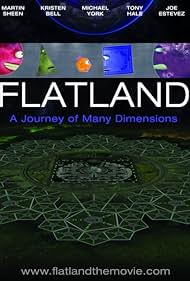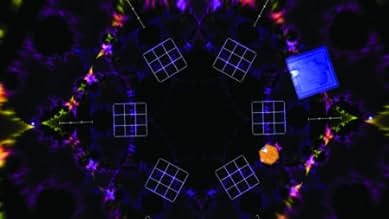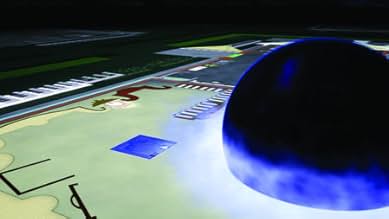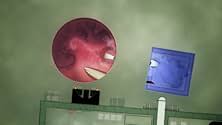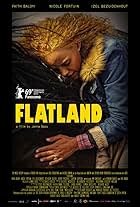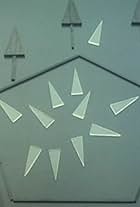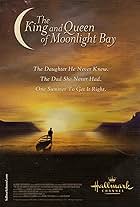Agrega una trama en tu idiomaBased on Edwin Abott's book "Flatland", this is an animated film about geometric characters living in a two-dimensional world. When a young girl named "Hex" decides to "think outside the box... Leer todoBased on Edwin Abott's book "Flatland", this is an animated film about geometric characters living in a two-dimensional world. When a young girl named "Hex" decides to "think outside the box" (in a world where such thought is forbidden), her life becomes in danger and it is up to... Leer todoBased on Edwin Abott's book "Flatland", this is an animated film about geometric characters living in a two-dimensional world. When a young girl named "Hex" decides to "think outside the box" (in a world where such thought is forbidden), her life becomes in danger and it is up to her grandfather to save her life.
- Dirección
- Guionistas
- Elenco
- Hex
- (voz)
- Spherius
- (voz)
Opiniones destacadas
Yes. I will admit that, visually, "Flatland" had some "OK" moments - But, for the most part, its story contained way too much mean-mindedness and the whole scenario got pretty tired by repeatedly driving home the point about the existence of the 3rd dimension.
I was really hoping that "Flatland" was going to be one helluva total roller-coaster ride of non-stop animation wizardry, but, instead, it was, pretty much, the same/old, same/old from start to finish.
In my experience watching this, everyone in my class loved it and almost busted.... out laughing! Spherius made me learn that there is more dimensions than the amount we live in. It made me and my fellow students question the dimensions and ponder about more dimensions than the 3 we mainly know about. The character development of Arthur Square is amazing from not even thinking about the third dimension to being imprisoned by the circles because he tried to say the truth about the third dimension.
In conclusion Flatland is one of the best educational movies out there!
Additionally, the on screen interviews with Martin Sheen, Kristen Bell, Tony Hale and Michael York are superb. Hearing them encourage students to learn about math is refreshing and should be a great motivational tool. There's also a great featurette about the 4th dimension - even I could almost understand it, thanks to the amazing visuals!
The novel was deep and meaningful and this film is light and useless. I was hoping for something close to the original with some helpful graphics. There was some value graphically speaking as far as illustrating the dimensions and this would have been very challenging no doubt. But to completely change the story line and turn it into some kind of mediocre fairy tale was a huge mistake in my opinion.
If you are a fan of the novel and are looking here to see if watching this film is worth it, it's not. Don't do it to yourself. You have been warned.
The source material for both is the 1884 novella by Edwin A. Abbott, but the approaches of the two films differ radically. The book is a staple of science fiction, and one of the few to address mathematical issues at its core. Being a product of its time, the book is technically naive, and politically incorrect based on current sensibilities.
The Travis film is visually slicker, but significantly shorter, and tackles philosophical issues relative to the passage of time from initial publication. As such, it tampers with the plot to mixed effect. Unlike some others, I have no problem with some of the revisions to the underlying plot since they do help bring some of the book's major issues into somewhat sharper focus. On the other hand, they also add a "feel good" and politically correct sensibility that seems out of place.
The Ehlinger film is much truer to its source material, which is both a strength and a weakness. Given a current perspective, its 19th century depiction of the political and social subjugation of women is a distraction that the Travis film avoids. It's also a longer film and could have been more effective with some of the same plot and editing license employed in the Travis film. Where it does tamper with the plot, some of the decisions are questionable as other reviewers have pointed out.
So which is better? In my opinion, the short answer is the Ehlinger film. Despite its length, political incorrectness, and technical inferiority (the animation of the Travis film is much more sophisticated), it resonates at a technical level to a degree that the Travis film can't match. As a scientist, this means a lot to me. On the other hand, the Travis film resonates on an emotional level that the Ehlinger film can't match. So the answer may be whether you're looking for technical insight or emotional satisfaction.
Most jarring in the Travis film is that, unlike the Ehlinger film, the animators never quite caught on to the implications of a two-dimensional universe. It is filled with objects which are instantly recognizable to us, yet would be clearly impossible or meaningless in the film's reality (e.g. the protagonist's daughter has toys which only make sense to someone with a 3-D perspective, and how does he open his briefcase?). The cover art is an obvious first impression example. The Travis film's characters look more human, but ask yourself how their eyes work. One detail of the book is that looking at a Flatlander from above, all of his internal organs are clearly visible, as they should be. Travis' animators hint at this, but don't meet it head-on. The Ehlinger film's animators may not have had the resources to make as slick a film as Travis', but they obviously gave a great deal of thought to what they were doing (or maybe not, since the necessary designs were all in the book). In short, Travis had the budget, but Ehlinger had the passion for the project - albeit perhaps a bit too much respect for the source to create a truly superior adaptation.
The differences reflect different target audiences, though. The Travis film is an educational short film which was obviously meant to be viewed by classrooms of middle school and high school students. As such, it had to be socially inoffensive while conveying concepts of geometry that would never occur to non-mathematicians. That it includes recognizable names voicing the characters will help it grab a bit more attention - an educational short film for the "X-Files" generation. The Ehlinger film would mostly appeal to people with a college level interest in mathematics, or others who are already familiar with the book.
Neither film is perfect, but I'm giving the Ehlinger film a rating of 8 and the Travis film a rating of 6. Depending on your sensibilities, your conclusion may be exactly opposite of mine, so I hope this review includes enough information to guide you to an informed selection.
Or, like me, you could simply buy both... ;-)
Argumento
¿Sabías que…?
- TriviaThe forbidden area in Flatland is named "Area 33H". "33" in hexadecimal ("H") is "51" in the decimal system, making this a sly reference to Area 51.
- ErroresThe spinning cube at the center of Area 33H shows up as a changing hexagon within Flatland. By analogy, the spinning hypercube at the end of the movie should appear as a changing polyhedral solid, but instead it appears as the full convex-hull three-dimensional projection.
- Citas
Female Boss Circle: [to A Square, who is late arriving at the office] Get to your Square-icle! NOW!
- Créditos curiososThe film opens with the following message: 'This movie has been modified from its original version. It has been formatted to fit your Spaceland screen. Certain elements from Flatland have been altered to be recognizable by three-dimensional beings. Any similarity to people, places or objects in our world is purely coincidental.'
- ConexionesReferenced in Dragon Day (2013)
Selecciones populares
Detalles
- País de origen
- Sitio oficial
- Idioma
- También se conoce como
- Flatland
- Locaciones de filmación
- Productora
- Ver más créditos de la compañía en IMDbPro
- Tiempo de ejecución34 minutos
- Color
Contribuir a esta página

